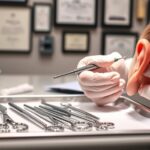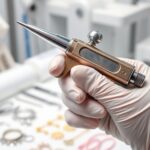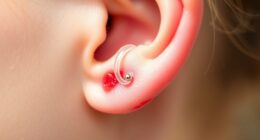When interviewing professional piercers, focus on their training in safety protocols, anatomy knowledge, and precise techniques. Ask about their experience with various piercings, sterilization practices, and how they educate clients on aftercare. Pay attention to their understanding of jewelry selection for different anatomy types. Skilled piercers prioritize safety and continue learning to stay updated. If you keep exploring, you’ll discover how these skills verify safe, high-quality piercings and help you choose the right professional.
Key Takeaways
- Verify the piercer’s certification and formal training in infection control and piercing techniques.
- Assess their knowledge of anatomy and jewelry selection for safe, precise piercings.
- Inquire about their experience with various piercing types and client care procedures.
- Evaluate their understanding of sterilization protocols and safety standards.
- Discuss their commitment to ongoing education and staying current with industry best practices.

Becoming a skilled piercer requires more than just a steady hand—you need proper training and a solid understanding of safety protocols. Piercing safety is the foundation of your craft, guaranteeing both your clients’ well-being and your professional reputation. You’ll learn how to maintain a sterile environment, properly sanitize tools, and follow strict hygiene practices. This training isn’t just about avoiding infection; it’s about building trust with your clients. When they see you’re serious about safety, they’ll feel more comfortable and confident in your skills.
Mastering safety protocols builds trust and ensures client well-being in professional piercing.
A essential part of achieving piercing safety is understanding anatomy. Knowing where to place piercings without damaging nerves or blood vessels can prevent complications. Training programs often include detailed lessons on facial and body anatomy, so you know exactly what to avoid. This knowledge also guides you in choosing the right jewelry, which is another fundamental aspect of your work. Jewelry selection isn’t just about aesthetics; it’s about functionality and safety. You’ll learn to select hypoallergenic materials like surgical steel or titanium, reducing the risk of allergic reactions. The size, shape, and post type of the jewelry must match your client’s anatomy and healing needs, guaranteeing a comfortable and secure fit.
During your training, you’ll also focus on piercing techniques that minimize trauma to the tissue. Proper needle placement, angle, and pressure are essential to achieve clean, precise piercings that heal well. This precision reduces pain and decreases the likelihood of migration or rejection. You’ll develop an eye for detail, which helps in selecting jewelry that complements the piercing site and fits seamlessly with the client’s anatomy.
Your education will emphasize the importance of client consultation. Asking the right questions about medical history, allergies, and lifestyle helps you recommend the best jewelry options and guarantee piercing safety. You’ll learn how to educate clients on aftercare, which is necessary for preventing infections and ensuring proper healing. Clear instructions about cleaning routines and avoiding irritants are part of your responsibility.
Ultimately, becoming proficient as a piercer involves continuous learning. Staying updated on advances in piercing safety standards and jewelry materials keeps your skills sharp. Combining technical expertise with a genuine concern for clients’ health fosters a professional reputation. When you master both piercing safety and jewelry selection, you not only perform beautiful piercings but also become a trusted expert in your field.
Frequently Asked Questions
What Certifications Are Essential for Professional Piercers?
You need to have essential piercing certifications that demonstrate your knowledge of safety standards and proper techniques. These certifications, like Bloodborne Pathogens and First Aid, ensure you prioritize client safety. Many states also require specific licensing or certifications to legally perform piercings. Staying current with safety standards not only boosts your credibility but also safeguards your clients and your career, making these certifications a must for professional piercers.
How Do Piercers Stay Updated on Safety Standards?
Staying current on safety standards is like tending a delicate garden—you must nurture it regularly. You do this by actively engaging in continuing education, attending workshops, and following industry updates. You also stay sharp by reviewing safety protocols and participating in professional forums. This ongoing effort guarantees you’re always in sync with the latest practices, safeguarding clients and maintaining your reputation as a skilled, responsible piercer.
What Are Common Challenges Faced During Piercing Procedures?
During piercing procedures, you often face challenges like managing piercing complications such as infections or allergic reactions. Customer communication is essential; you need to clearly explain aftercare and address concerns to guarantee comfort and safety. Staying vigilant helps prevent issues, and maintaining open dialogue allows clients to feel confident. By anticipating these common challenges, you can provide a smoother experience and reduce the risk of complications.
How Do Piercers Handle Customer Concerns and Anxiety?
You handle customer concerns and anxiety through effective customer communication and anxiety management techniques. You listen carefully, calmly address their worries, and provide clear explanations about the procedure. Using reassuring language and demonstrating professionalism helps ease their fears. You also create a comfortable environment, encouraging questions and offering support throughout the process. This approach builds trust, reduces anxiety, and ensures a positive piercing experience for your clients.
What Advances Are Shaping the Future of Piercing Techniques?
You’ll find that new materials and laser technology are revolutionizing piercing techniques. For example, 65% of professional piercers now use hypoallergenic, biocompatible materials, reducing complications. Laser technology allows for more precise, minimally invasive piercings with quicker healing times. These advances improve safety and comfort, making piercings more accessible and appealing. Embracing these innovations guarantees you stay ahead in the evolving world of body art.
Conclusion
So, as you consider stepping into the world of professional piercing, remember that mastering your craft requires dedication and a keen eye for detail. With proper training and a gentle touch, you’ll create memorable experiences that clients cherish. Embrace each lesson as a stepping stone to becoming a trusted artist in the industry. Your journey is just beginning, and with patience, you’ll find your unique way to shine brightly in this enthralling field.
















